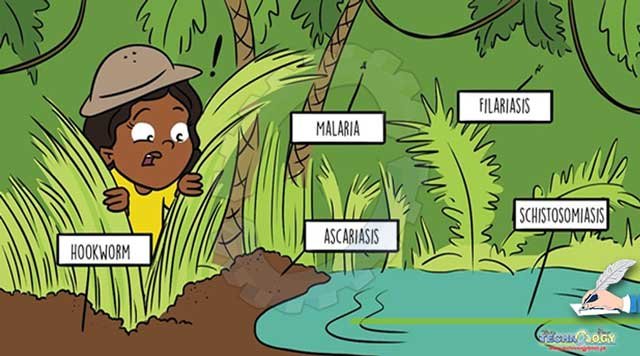Parasites are the organisms that live off organisms, or hosts to survive. They depend on the host for food and shelter. Parasites are a serious problem in tropical and subtropical areas.

By Akasha Tanveer , Dr. Muhammad Sohail Sajib
What are Parasites?
These parasites are transmitted to the human or animal population by contaminated food or water, contact with an infected individual, and sometimes via intercourse.
Many parasitic diseases require a carrying organism, Vector, to be delivered to a susceptible host. These diseases are characterized as Vector Borne diseases (VBD). The vectors include variety of arthropods like ticks, mosquitoes, mites, and flies.
Some significant parasitic diseases include Malaria, Dengue, Toxoplasmosis, trichomoniasis, and Giardia. VBD are babesiosis, theileriosis, schistosomiasis, chagas disease, and leishmanisis.
What are the signs and symptoms?
The sign and symptoms vary with the species parasitizing the host. They may cause no effect at all and at times, may invade the organs causing fatal signs and symptoms. Some may exhibit signs like diarrhea, while others may cause severe anemia and damage to the liver (liver cirrhosis). In the case of trichomoniasis, a sexually transmitted disease often causes no apparent signs. In some cases, itching and redness of genitalia are reported. In Giardiasis and Balantidiasis, diarrhea and stomach pain is the usual complaint.
What causes parasitic infection?
The Parasitic infection is caused by 3 organisms:
- Protozoa
- Ecto-parasites
- Helminthes
Protozoa are single-celled organisms that live inside the body. These include giardia, which enters the body by drinking contaminated water.
Helminthes are multicellular organisms that live either in the body or outside the body. These include tapeworms, roundworms, and flatworms.
Ectoparasites are also multicellular that infest the skin. These include ticks, mites, mosquitoes, fleas, and lice. They not only damage the skin but also transmit pathogens while taking the blood meal from the host. These are called Vector-Borne diseases, for example, Malaria, East Coast Fever, West Nile Fever, and Dengue.
Who is susceptible to infection?
Everyone is susceptible to parasitic infection but some are at greater risk. Following is the list of those with a higher risk of getting infected:
- Immuno-compromised individuals or those already having any
- People living or traveling to areas with endemic
- People with no availability of clean water and food
- Workers in contact with human
Stray animals can also become a source of infection. Usually, pet cats who roam outside can get infected with toxoplasma gondii. These cats become harmful for pregnant females, if any, in the house.
How parasitic infection can be diagnosed?
There are several ways to diagnose parasitic infection. A blood test can be performed to diagnose parasites in the blood. In the same way, fecal tests help with those parasites that are excreted in the feces. Colonoscopy or Endoscopy can be performed to examine the digestive tract. Various modern techniques like X-Rays, MRI, and CAT can be used to detect any damage in organs or the presence of any parasite inside the body. Diagnostic techniques and test availability may vary according to the area.
How parasitic diseases are treated?
The treatment is decided according to the diagnosis made by the Doctor/ Veterinarian. There are specific medicines according to the disease. Some supportive and symptomatic treatment can be given to mitigate the symptoms.
How to prevent parasitic disease?
You need to follow some simple steps to avoid any serious infection.
- Wash your hands whenever in contact with any waste or contaminated
- Use clean water for drinking. Avoid drinking from ponds, and
- Cook food to the recommended
- Avoid contact with cats if you’re
Consult the doctor/ veterinarian if you have or your animal, respectively, has any signs or symptoms.
National Scenario of Parasitic Infection
With changing climate and planet, the pathogens including parasites are also changing. Some diseases are becoming negligent while many are now reported which were not present before. Hot and humid weather is increasing the population of vectors, which in turn is reported as a higher prevalence of the specific disease. A heavy burden of fatal VBD (Vector-borne diseases)
i.e Leishmaniasis, Crimean-Congo haemorrhagic fever has been reported in Pakistan.
We can take precautionary measure to control the presence of these vectors in our close vicinity to avoid the disease.
References:
Lucius, R., Loos-Frank, B., Lane, R. P., Poulin, R., Roberts, C., & Grencis, R. K. (2017). The biology of parasites. John Wiley & Sons.
Parasites. (2016, July 28). Retrieved from cdc.gov/parasites/